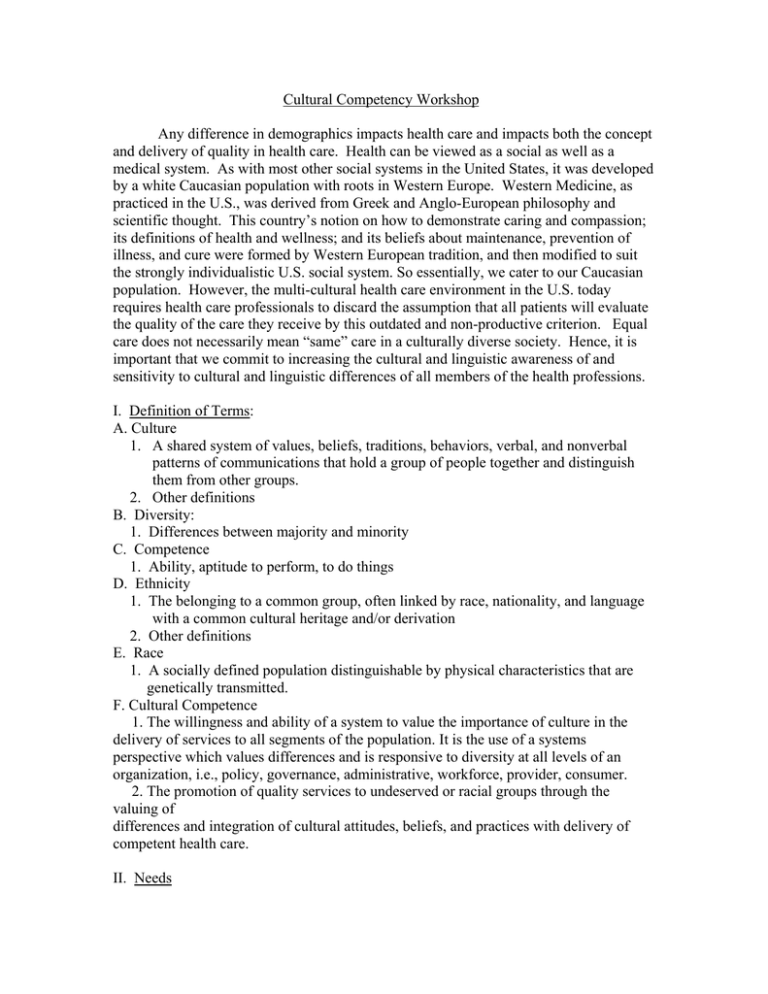Cultural Competency Workshop
advertisement

Cultural Competency Workshop Any difference in demographics impacts health care and impacts both the concept and delivery of quality in health care. Health can be viewed as a social as well as a medical system. As with most other social systems in the United States, it was developed by a white Caucasian population with roots in Western Europe. Western Medicine, as practiced in the U.S., was derived from Greek and Anglo-European philosophy and scientific thought. This country’s notion on how to demonstrate caring and compassion; its definitions of health and wellness; and its beliefs about maintenance, prevention of illness, and cure were formed by Western European tradition, and then modified to suit the strongly individualistic U.S. social system. So essentially, we cater to our Caucasian population. However, the multi-cultural health care environment in the U.S. today requires health care professionals to discard the assumption that all patients will evaluate the quality of the care they receive by this outdated and non-productive criterion. Equal care does not necessarily mean “same” care in a culturally diverse society. Hence, it is important that we commit to increasing the cultural and linguistic awareness of and sensitivity to cultural and linguistic differences of all members of the health professions. I. Definition of Terms: A. Culture 1. A shared system of values, beliefs, traditions, behaviors, verbal, and nonverbal patterns of communications that hold a group of people together and distinguish them from other groups. 2. Other definitions B. Diversity: 1. Differences between majority and minority C. Competence 1. Ability, aptitude to perform, to do things D. Ethnicity 1. The belonging to a common group, often linked by race, nationality, and language with a common cultural heritage and/or derivation 2. Other definitions E. Race 1. A socially defined population distinguishable by physical characteristics that are genetically transmitted. F. Cultural Competence 1. The willingness and ability of a system to value the importance of culture in the delivery of services to all segments of the population. It is the use of a systems perspective which values differences and is responsive to diversity at all levels of an organization, i.e., policy, governance, administrative, workforce, provider, consumer. 2. The promotion of quality services to undeserved or racial groups through the valuing of differences and integration of cultural attitudes, beliefs, and practices with delivery of competent health care. II. Needs A. Basic knowledge 1. Language, facial, or spoken 2. Cultural traditions: In Korean culture, looking down is a sign of respect, however, it is taken as “holding something back” sign by the western health professional. Another example is the case study of a three-Hmong child with epilepsy, believed to have lost his soul in the Hmong culture. An American Indian woman was noted by her Western doctor to be depressed. She told him that her uncle sexually assaulted her when she was young, so the doctor put her on anti-depressants and psychotherapy sessions. However, it did not help her completely. So, he consulted a Native American medicine man that then met with the family and performed a traditional purification ceremony to purify her spirit from incest. 3. Open mindedness: Do not make judgments or assumptions. 4. Ability to understand the role of culture in one’s attitudes and behavior 5. Avoid breaching patient’s taboos, 6. Use trained translators B. Awareness C. Sensitivity D. Trust/Confidence in one’s ability to offer quality care to patients of other cultures E. Security and protection III. Cultural barriers/clashes/conflicts A. Stereotypes B. Language C. Hastiness D. Racism/Bias/Prejudice Other Issues: An example might be riding in a car with your friend who is going 35 miles in a 20 mile-zone. He hits a pedestrian, who was not badly hurt. However, the lawyer subtly mentions that, if you testify saying that he was going 20 miles per hour, your friend won’t suffer any serious consequences. Would you testify that your friend was driving 20 miles an hour (Yes/No)? Four percent of Americans and 66% of Venezuelans said they would (U.S. Peace Corps). E. Contrast American Values Contrast Values Individualism/Independence Group welfare/Dependence Time and its control/sequential time Human interaction/Synchronous time Future orientation Past orientation Action/work/competition Being/cooperation Change and newness Stability/tradition/continuity Self-help/initiative/achieved status/inner direction Equality/fairness/rules Birthright inheritance/Ascribed status/ outer direction Hierarchy/rank/status Responsibility/role destiny/fate Informality Formality Directness/openness/honesty Indirectness/ritual/face Practicality/efficiency Idealism/Theory Materialism/Acquisitiveness Spiritualism/detachment IV. Assessment Tests ¾ Self-Assessment: Include topics like family origins, prejudice, bias, ancestry, ethnic advantages and disadvantages. Discuss similarities and differences in comparing a group of people. ¾ Study: Research a community you would like to read and learn about. Seek a community leader and/or traditional healers to learn of the culture. Learn about the demographics, health and illness beliefs, restoring health, home remedies, practices, beliefs, food, etc. ¾ Discussion: Discuss case studies (see attachment). Expound on your responses. What went wrong? What is the cause? What is your reaction? Does the situation provoke feelings of anxiety and discomfort? ¾ Experience: Host a traditional cultural lunch or dinner and brief the audience about this particular culture. What did you learn? Convey this lesson to the group by providing a poster presentation, a meeting, or a skit. ¾ Other IV. Community Outreach To reach a minority community, you first need to: 9 Respect the community you are reaching and trying to learn about. 9 Conduct a community needs assessment. 9 Bring services to the community (curanderas, etc.). 9 Structure programs designed to increase responses of health care providers to minority populations. 9 Engage family linkages. 9 Answer all these questions as may be pertinent to the medical condition of your client, including: cause of the problem, how it started, what does your sickness do to you, how severe, are there fears, what kind of treatment, and the most important results you hope to receive from treatment. 9 Link existing services. If you are able to positively respond to all these key issues, then you are culturally competent!






